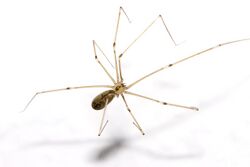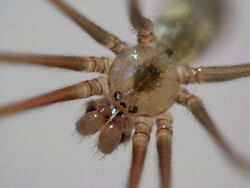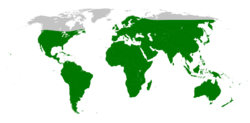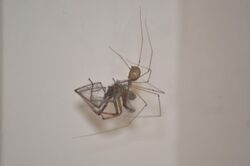Biology:Pholcidae
| Pholcidae | |
|---|---|

| |
| Pholcus phalangioides | |

| |
| Close-up of a cellar spider's cephalothorax, showing two groups of three clustered eyes | |
| Scientific classification | |
| Domain: | Eukaryota |
| Kingdom: | Animalia |
| Phylum: | Arthropoda |
| Subphylum: | Chelicerata |
| Class: | Arachnida |
| Order: | Araneae |
| Infraorder: | Araneomorphae |
| Family: | Pholcidae C. L. Koch, 1850 |
| Diversity | |
| 94 genera, 1820 species | |

| |
| Estimated range of Pholcidae. | |
The Pholcidae are a family of araneomorph spiders. The family contains more than 1,800 individual species of pholcids, including those commonly known as cellar spider, daddy long-legs spider, carpenter spider, daddy long-legger, vibrating spider, gyrating spider, long daddy, and skull spider. The family, first described by Carl Ludwig Koch in 1850,[1] is divided into 94 genera.[2]
The common name "daddy long-legs" is used for several species, especially Pholcus phalangioides, but is also the common name for several other arthropod groups, including harvestmen and crane flies.
Appearance
Pholcids are thin and delicate arachnids. The body, resembling the shape of a peanut, is approximately 2–10 mm (0.08–0.39 inch) in length, and the legs may be up to 50 mm (1.97 inches) long. Pholcus and Smeringopus have cylindrical abdomens and eyes arranged in two lateral groups of three and two smaller median contiguous eyes. Arrangements of eight and six eyes both occur in this family. Spermophora has a small globose abdomen and its eyes are arranged in two groups of three without median eyes. Pholcids are gray to brown, sometimes clear, with banding or chevron markings.
Identification
These spiders have legs roughly 4 times as large as their bodies, making them look quite a lot like harvestmen (Opiliones). But they can be easily differentiated by the two segments, that members of this family have, while harvestmen have fused segments.[3] They can be further distinguished by their irregular structure, and usually brown, tan or grey coloration.
Habitat
Pholcids are found in every continent in the world except Antarctica. Pholcids hang inverted in their messy and irregular-shaped webs. These webs are constructed in dark and damp recesses such as in caves, under rocks and loose bark, and in abandoned mammal burrows. In areas of human habitation pholcids construct webs in undisturbed areas in buildings such as high corners, attics and cellars, hence the common name "cellar spider".[4]
Behavior
File:Crossopriza lyoni Video.ogv
Trapping
The web of pholcids has no adhesive properties and instead relies on its irregular structure to trap prey. When pholcid spiders detect prey within their webs the spiders quickly envelop prey with silk-like material. The prey may be eaten immediately or stored for later. When finished feeding they will clean the web by unhooking the remains of the prey and letting the carcass drop from the web. They are passive against humans.
Threat response
Some species of Pholcidae exhibit a threat response when disturbed by a touch to the web or entangled large prey. The arachnid responds by vibrating rapidly in a gyrating motion in its web, which may sometimes fall into a circular rhythm. It may oscillate in tune with the elasticity of the web causing an oscillation larger than the motion of the spider's legs. While other species of spider exhibit this behaviour, such behavior by the Pholcidae species has led to these spiders sometimes being called "vibrating spiders". There are several proposed reasons for this threat response. The movement may make it difficult for a predator to locate or strike the spider, or may be a signal to an assumed rival to leave. Vibrating may also increase the chances of capturing insects that have just brushed their web and are still hovering nearby, or further entangle prey that may have otherwise been able to free itself.[5] If the spider continues to be disturbed it will retreat into a corner or drop from its web and escape.
Diet
Although they do eat insects, certain species of these spiders invade webs of other spiders to eat the host, the eggs, or the prey. In some cases the spider vibrates the web of other spiders, mimicking the struggle of trapped prey to lure the host closer. Pholcids prey on Tegenaria funnel weaver spiders, and are known to attack and eat redback spiders, huntsman spiders and house spiders.[6][7]

Pholcids may be beneficial to humans living in regions with dense hobo spider populations as predation on Tegenaria may keep populations in check.[8] They have also been observed to feed on the spider Steatoda nobilis in countries like Ireland and England.[9]
Gait
Pholcus phalangioides often uses an alternating tetrapod gait (first right leg, then second left leg, then third right leg, etc.), which is commonly found in many spider species. However, frequent variations from this pattern have been documented during observations of the spiders' movements.
Misconceptions
There is an urban legend that daddy long-legs spiders have the most potent venom of any spider but that their fangs are either too small or too weak to puncture human skin; the same legend is also repeated of the harvestman and crane fly, also known as daddy long-legs in some regions. This is not true for any of the three. Pholcidae are indeed capable of biting humans and their venom is not medically significant, and neither harvestmen nor crane flies have any venom or fangs to speak of. Indeed, pholcid spiders do have a short fang structure (called uncate due to its "hooked" shape). Brown recluse spiders also have uncate fang structure, but are able to deliver medically significant bites.
Possible explanations include: pholcid venom is not toxic to humans; pholcid uncate are smaller than those of brown recluse; or there is a musculature difference between the two arachnids, with recluses, being hunting spiders, possessing stronger muscles for fang penetration.[10] According to Rick Vetter of the University of California, Riverside, the daddy long-legs spider has never harmed a human, and there is no evidence that they are dangerous to humans.[11]
The legend may result from the fact that the daddy long-legs spider preys upon deadly venomous spiders, such as the redback, and other members of the true widow genus Latrodectus.[12] To the extent that such arachnological information was known to the general public, it was perhaps thought that if the daddy long-legs spider could kill a spider capable of delivering fatal bites to humans, then it must be more venomous, and the uncate fangs were regarded as prohibiting it from killing people. In reality, it is able to cast lengths of silk onto its prey, incapacitating them from a safe distance.[13]
Mythbusters experiment
During 2004, the Discovery Channel television show MythBusters tested the daddy long-legs venom myth in episode 13, "Buried in Concrete". Hosts Jamie Hyneman and Adam Savage first established that the spider's venom was not as toxic as other venoms, after being told about an experiment whereby mice were injected with venom from both a daddy long-legs and a black widow, with the black widow venom producing a much stronger reaction. After measuring the spider's fangs at approximately 0.25 mm, Adam Savage inserted his hand into a container with several daddy-long-legs, and reported that he felt a bite which produced a mild, short-lived burning sensation. The bite did in fact penetrate his skin, but did not cause any notable harm.[14] Additionally, recent research has shown that pholcid venom is relatively weak in its effects on insects.[15]
Genera
(As of April 2019), the World Spider Catalog accepted the following genera:[2]
- Aetana Huber, 2005 – Asia, Fiji
- Anansus Huber, 2007 – Africa
- Anopsicus Chamberlin & Ivie, 1938 – Mexico, Ecuador, Caribbean, Central America
- Apokayana Huber, 2018 – Malaysia, Indonesia
- Arenita Huber & Carvalho, 2019 – Brazil
- Arnapa Huber, 2019 – Indonesia, Papua New Guinea
- Artema Walckenaer, 1837 – Asia, Africa
- Aucana Huber, 2000 – Chile
- Aymaria Huber, 2000 – South America
- Belisana Thorell, 1898 – Asia, Oceania
- Blancoa Huber, 2000 – Venezuela
- Buitinga Huber, 2003 – Africa
- Calapnita Simon, 1892 – Asia
- Canaima Huber, 2000 – Trinidad, Venezuela
- Cantikus Huber, 2018 – Asia
- Carapoia González-Sponga, 1998 – South America
- Cenemus Saaristo, 2001 – Seychelles
- Chibchea Huber, 2000 – South America
- Chisosa Huber, 2000 – Mexico, Aruba, United States
- Ciboneya Pérez, 2001 – Cuba
- Coryssocnemis Simon, 1893 – Trinidad, South America, Mexico, Central America
- Crossopriza Simon, 1893 – Asia, Africa, United States, Venezuela, Germany, Australia
- Enetea Huber, 2000 – Bolivia
- Galapa Huber, 2000 – Ecuador
- Gertschiola Brignoli, 1981 – Argentina
- Giloloa Huber, 2019 – Indonesia
- Guaranita Huber, 2000 – Argentina, Brazil
- Hantu Huber, 2016 – Indonesia
- Holocneminus Berland, 1942 – Asia, Samoa
- Holocnemus Simon, 1873 – Spain, Italy, Portugal
- Hoplopholcus Kulczyński, 1908 – Asia, Greece
- Ibotyporanga Mello-Leitão, 1944 – Brazil
- Ixchela Huber, 2000 – Mexico, Central America
- Kairona Huber & Carvalho, 2019 – Brazil
- Kambiwa Huber, 2000 – Brazil
- Kelabita Huber, 2018 – Indonesia, Malaysia
- Khorata Huber, 2005 – Asia
- Kintaqa Huber, 2018 – Thailand, Malaysia
- Leptopholcus Simon, 1893 – Asia, Africa
- Litoporus Simon, 1893 – South America
- Magana Huber, 2019 – Oman
- Mecolaesthus Simon, 1893 – Caribbean, South America
- Meraha Huber, 2018 – Asia
- Mesabolivar González-Sponga, 1998 – South America, Trinidad
- Metagonia Simon, 1893 – North America, South America, Central America, Caribbean
- Micromerys Bradley, 1877 – Papua New Guinea, Australia
- Micropholcus Deeleman-Reinhold & Prinsen, 1987 – Morocco, Caribbean, Europe, Asia, Australia
- Modisimus Simon, 1893 – North America, Central America, Caribbean, Germany, Seychelles, Asia, Australia, South America
- Muruta Huber, 2018 – Malaysia
- Nerudia Huber, 2000 – Chile, Argentina
- Ninetis Simon, 1890 – Africa, Yemen
- Nipisa Huber, 2018 – Asia
- Nita Huber & El-Hennawy, 2007 – Egypt, Iran, Uzbekistan
- Nyikoa Huber, 2007 – Central Africa
- Ossinissa Dimitrov & Ribera, 2005 – Canary Is.
- Otavaloa Huber, 2000 – South America
- Paiwana Huber, 2018 – Taiwan
- Panjange Deeleman-Reinhold & Deeleman, 1983 – Asia, Oceania
- Papiamenta Huber, 2000 – Curaçao
- Paramicromerys Millot, 1946 – Madagascar
- Pehrforsskalia Deeleman-Reinhold & van Harten, 2001 – Africa, Asia
- Pemona Huber, 2019 – Venezuela
- Pholcophora Banks, 1896 – United States, Canada, Mexico
- Pholcus Walckenaer, 1805 – Asia, Europe, Africa, United States, Oceania
- Physocyclus Simon, 1893 – North America, South America, Czech Republic, Asia, Australia, Central America
- Pinocchio Huber & Carvalho, 2019 – Brazil
- Pisaboa Huber, 2000 – Peru, Venezuela, Bolivia
- Pomboa Huber, 2000 – Colombia
- Pribumia Huber, 2018 – Asia
- Priscula Simon, 1893 – South America
- Psilochorus Simon, 1893 – North America, South America, Asia, New Zealand
- Quamtana Huber, 2003 – Africa
- Queliceria González-Sponga, 2003 – Venezuela
- Saciperere Huber & Carvalho, 2019 – Brazil
- Savarna Huber, 2005 – Thailand, Malaysia, Indonesia
- Smeringopina Kraus, 1957 – Africa
- Smeringopus Simon, 1890 – Africa, Asia, Australia
- Spermophora Hentz, 1841 – Africa, Asia, Oceania, Germany, Brazil, United States
- Spermophorides Wunderlich, 1992 – Africa, Europe
- Stenosfemuraia González-Sponga, 1998 – Venezuela
- Stygopholcus Absolon & Kratochvíl, 1932 – Croatia, Greece, Montenegro
- Systenita Simon, 1893 – Venezuela
- Tainonia Huber, 2000 – Hispaniola
- Teranga Huber, 2018 – Indonesia, Philippines
- Tibetia Zhang, Zhu & Song, 2006 – Tibet
- Tissahamia Huber, 2018 – Asia
- Tolteca Huber, 2000 – Mexico
- Trichocyclus Simon, 1908 – Australia
- Tupigea Huber, 2000 – Brazil
- Uthina Simon, 1893 – Asia, Seychelles
- Wanniyala Huber & Benjamin, 2005 – Sri Lanka
- Waunana Huber, 2000 – Colombia, Ecuador, Panama
- Wugigarra Huber, 2001 – Australia
- Zatavua Huber, 2003 – Madagascar
-
Artema nephilit
-
Two Crossopriza lyoni. The bottom one is male. The female is clutching her egg bundle (magnified).
-
A marbled cellar spider (Holocnemus pluchei) carrying prey.
-
Smeringopus pallidus female with egg sac.
-
Male shortbodied cellar spider (Spermophora senoculata) from the United States
-
Uthina atrigularis
References
Citations
- ↑ Koch, C. L. (1850). Übersicht des Arachnidensystems. doi:10.5962/bhl.title.39561. https://www.biodiversitylibrary.org/bibliography/39561.
- ↑ 2.0 2.1 "Family: Pholcidae C. L. Koch, 1850". Natural History Museum Bern. http://www.wsc.nmbe.ch/family/76.
- ↑ "Pholcidae - Bugwoodwiki". https://wiki.bugwood.org/NPIPM:Pholcidae.
- ↑ "Pholcidae information" (in en). http://www.biokids.umich.edu/critters/Pholcidae/.
- ↑ Marlin, Bruce (25 April 2006). Video of the "vibrating spider" vibrating (QuickTime Movie).
- ↑ "Daddy Long Legs". Queensland Museum. http://www.qm.qld.gov.au/Find+out+about/Animals+of+Queensland/Spiders/Modern+Spiders+Infraorder+Araneomorphae/Daddy-long-legs+spiders/Daddy-long-legs.
- ↑ Wim van Egmond. "Pholcus phalangioides, the daddy-long-legs spider, in 3D". http://www.microscopy-uk.org.uk/mag/indexmag.html?http://www.microscopy-uk.org.uk/mag/spider/pholcus1.html.
- ↑ "Pholcus phalangioides (Long-bodied Cellar Spider) – Spider Identification & Pictures". https://spiderid.com/spider/pholcidae/pholcus/phalangioides/.
- ↑ Dugon, Michel M.; Dunbar, John P.; Afoullouss, Sam; Schulte, Janic; McEvoy, Amanda; English, Michael J.; Hogan, Ruth; Ennis, Collie et al. (2017). "Occurrence, reproductive rate and identification of the non-native Noble false widow spider Steatoda nobilis (Thorell, 1875) in Ireland". Biology and Environment: Proceedings of the Royal Irish Academy 117B (2): 77–89. doi:10.3318/bioe.2017.11. ISSN 0791-7945. https://www.jstor.org/stable/10.3318/bioe.2017.11.
- ↑ "Daddy Long Legs Site on UCR". http://spiders.ucr.edu/daddylonglegs.html.
- ↑ "Spider Myths – Daddy Long Legs". http://spiders.ucr.edu/daddylonglegs.html.
- ↑ "Family Pholcidae – daddy long-leg spiders". 2009. http://www.brisbaneinsects.com/brisbane_weavers/Pholcidae.htm.
- ↑ "Daddy long-legs". http://www.tepapa.govt.nz/researchattepapa/enquiries/spidersweb/what/pages/daddylonglegs.aspx.
- ↑ "Daddy long-leg spiders". Discovery channel. http://dsc.discovery.com/fansites/mythbusters/db/animals/daddy-long-leg-spiders.html.
- ↑ "The Spider Myths Site". Burke Museum. 2005-05-12. http://www.washington.edu/burkemuseum/spidermyth/myths/daddyvenom.html.
General bibliography
- Harvestmen: The Biology of Opiliones. Harvard University Press. 2007. ISBN 978-0-674-02343-7.
External links
- "North American Spiders, Family Pholcidae". http://www.cirrusimage.com/spider_vibrating.htm. Information and reference quality photos of cellar spiders. Includes QuickTime movie of spiders "vibrating".
- "Information and pictures of European Pholcidae". http://www.xs4all.nl/~ednieuw/Spiders/Pholcidae/Pholcidae.htm.
- "Tree of Life Pholcidae". Tree of Life Web Project. http://tolweb.org/Pholcidae/2719.
Wikidata ☰ Q10995 entry
 |






